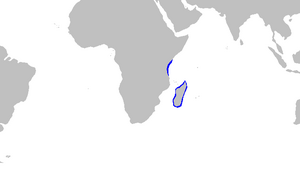Short-tail nurse shark facts for kids
Quick facts for kids Short-tail nurse shark |
|
|---|---|
 |
|
| Conservation status | |
| Scientific classification | |
| Genus: |
Pseudoginglymostoma
|
| Species: |
brevicaudatum
|
 |
|
| Range of short-tail nurse shark (in blue) | |
The short-tail nurse shark, known scientifically as Pseudoginglymostoma brevicaudatum, is a unique and often misunderstood shark species. Unlike the more commonly known nurse shark, this particular type is quite rare and lives in specific parts of the Indian Ocean. It's a bottom-dwelling shark, meaning it spends most of its time near the seabed, exploring for food.
The short-tail nurse shark gets its name from its relatively short tail compared to its body size, and its resemblance to other "nurse" sharks. These sharks are part of the family Ginglymostomatidae, which includes other well-known nurse sharks. They are generally slow-moving and peaceful creatures, often found resting during the day.
Contents
Appearance and Size
Short-tail nurse sharks have a distinctive appearance. They typically have a sturdy, somewhat flattened body, with a broad head and small eyes. Their skin is usually a brownish or grayish color, which helps them blend in with the rocky or sandy seafloor where they live. One of their most noticeable features is the presence of two barbels (whisker-like organs) near their nostrils, which they use to sense food in murky waters.
These sharks are not as large as some of their more famous relatives, like the great white shark. An adult short-tail nurse shark can grow to about 75 centimeters (around 2.5 feet) in length. This makes them a medium-sized shark, much smaller than many other shark species you might hear about.
Where Do They Live?
The short-tail nurse shark has a very limited geographic range. They are primarily found in the western Indian Ocean, specifically off the coast of East Africa. Their known habitats include the waters around countries like Mozambique, Tanzania, and Madagascar. They prefer shallow coastal waters, often found near coral reefs, rocky areas, or sandy bottoms at depths ranging from 1 to 40 meters (about 3 to 130 feet). Their preference for these specific environments highlights their adaptation to a life close to the seafloor.
What Do Short-tail Nurse Sharks Eat?
Like many bottom-dwelling sharks, the short-tail nurse shark is a carnivore, meaning it eats other animals. Their diet mainly consists of small invertebrates and fish that live on or near the seabed.
Hunting Habits
Short-tail nurse sharks are nocturnal hunters, meaning they are most active at night. During the day, they often rest in caves, crevices, or under ledges. When night falls, they emerge to forage for food. They use their barbels to detect prey hidden in the sand or among rocks. Once they locate a meal, they can use their strong jaws and small, sharp teeth to capture it. Their diet likely includes crabs, shrimp, small octopuses, and small bony fish.
Are Short-tail Nurse Sharks Dangerous to Humans?
Many people are curious about whether sharks are dangerous. When it comes to the short-tail nurse shark, the answer is generally no. These sharks are known for their calm and docile nature.
Short-tail nurse sharks are not aggressive towards humans. They are shy and tend to avoid contact. Because of their small size and bottom-dwelling habits, encounters with humans are rare, and when they do happen, the sharks typically swim away. There are no recorded incidents of unprovoked attacks by short-tail nurse sharks on humans. Divers who have encountered them describe them as peaceful creatures that pose no threat unless provoked or harassed. It's always important to remember that any wild animal, if threatened, might defend itself, but this is extremely unlikely with a short-tail nurse shark.
Why Are Short-tail Nurse Sharks Important?
Every species plays a role in its ecosystem, and the short-tail nurse shark is no exception. As a predator of small bottom-dwelling creatures, they help to maintain the balance of their marine environment. They are part of the complex food web that supports the health of coral reefs and coastal ecosystems.
Conservation Status
Due to their limited range and the fact that they are not frequently encountered, the exact population numbers of short-tail nurse sharks are not well-known. However, like many marine species, they face potential threats from human activities. These threats can include habitat degradation (damage to their living areas) from coastal development, pollution, and accidental capture in fishing nets (known as bycatch).
The International Union for Conservation of Nature (IUCN) assesses the conservation status of species worldwide. Understanding the population trends and threats to the short-tail nurse shark is crucial for ensuring its long-term survival.
Protecting Their Future
Protecting marine environments, especially coral reefs and coastal areas, is vital for the survival of the short-tail nurse shark and countless other species. Efforts to reduce pollution, manage fishing sustainably, and create marine protected areas can help safeguard these unique creatures and their habitats for future generations. Learning about these fascinating animals is the first step in appreciating and protecting them.


